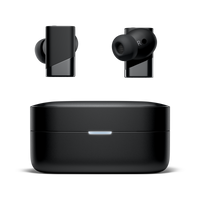
What is “Transparency Mode?”
If you’ve pulled the trigger on some wireless buds or headphones in the past few years, you have likely heard of - or experienced - “transparency mode” and the convenience it offers.
If you don’t already know, transparency mode, sometimes referred to as pass-through or ambient mode, is a feature that allows you to hear the noises in your surrounding environment without having to take off your headphones or pluck out your earbuds. If you own the Between 3ANC, you know that this feature can sometimes sound so good that you want to use the buds as recreational hearing aids - while if you’ve ever gone with some cheap n’ dirty buds, you may know that it can also sound pretty harsh and artificial.
But how does transparency mode even work in the first place? Luckily, it’s a concept that is about as simple as it is convenient.
How Does Transparency Mode Work?

Let’s use the Status Audio Between 3ANC as an example here. There are a total of 6 tiny microphones installed at precise locations and angles on the outer perimeter of the earbuds. These are called beamforming microphones.

Then, inside both the left and right buds, we see a DSP (Digital Sound Processing) chip. The beamforming microphones and DSP chip work together to carry out transparency mode - and ANC mode for that matter, but we won’t be getting into that here.

The beamforming microphones on the buds pick up the noise in your surrounding environment. They then send what they pick up to the DSP chip inside of the buds. The DSP chip combines the audio signals received by each microphone, resulting in in a summed signal that emulates your surrounding environment as your ears would more-or-less naturally hear it.
From there, the DSP chip can carry out one of two functions. In ANC mode, the chip plays a phase flipped version of the combined microphone signals to cancel out environmental noises (read a more in depth summary of how ANC functions). In transparency mode, the DSP chip leaves phase unaffected, and simply outputs the environmental noise through the speaker for your ears to hear.
You may notice that your buds or headphones have options within transparency mode that let you adjust the levels of environmental noise. This function is also performed by the DSP chip, which attenuates (lowers the volume) of the microphone signals according to to your preferred transparency level.
TL;DR
In transparency mode, microphones on your wireless buds or headphones are doing the listening for you. A special sound chip combines the audio signals it receives from the mics, and plays a summed signal through the speakers on your earbuds. The result is hearing the outside world with your buds still snug in your ears.
Most companies only throw a couple of microphones onto their wireless buds, which often results in harsh and artificial reproductions of outside noise. At Status Audio, we loaded 6 beamforming microphones at carefully calibrated positions all over the Between 3ANC, so you can hear the world as it naturally sounds - or cancel it out completely - with just a tap.





